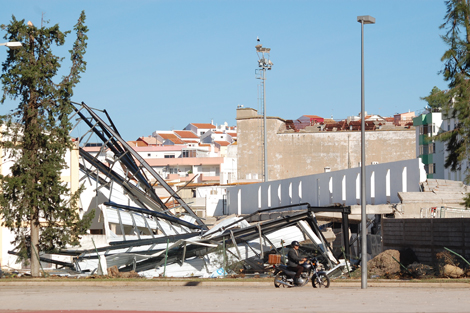 When Clark Gable tells Vivien Leigh, in the immortal classic Gone With the Wind: “Frankly, my dear, I don't give a damn” – basically, “My dear, I'm in the bud” – sums it up, unexpectedly , our stance, as a collective, in relation to the phenomenon of Climate Change.
When Clark Gable tells Vivien Leigh, in the immortal classic Gone With the Wind: “Frankly, my dear, I don't give a damn” – basically, “My dear, I'm in the bud” – sums it up, unexpectedly , our stance, as a collective, in relation to the phenomenon of Climate Change.
But in reality, as in fiction, sometimes the wind blows everything in front of you….
The municipalities of Lagoa and Silves, crossed by a calamity that left a trail of destruction and horror, were subjected to a test by fire regarding this lesson. However, it is important that we all draw learning and alertness from it.
Extreme weather phenomena have always occurred. They are part of the Planet's environmental dynamics, since its origin. So far, nothing strange. However, something is actually changing. Either in its intensity, increasing and with increasingly catastrophic effects, or in its periodicity, which is shorter and shorter. And even so, so far nothing too strange. “El Niño” and “La Niña” are also part of the overall scheme.
The problem is that, in the line of fire of these climatic phenomena, there are highly vulnerable beings who, although convinced of being endowed with superhuman powers, thanks to omnipotent technology, are actually fragile when confronted with the strength of natural elements , in its most extreme manifestations.
And it's not a matter of preparation. Not even if “they” (that obscure entity that, among other multiple things, gives us the weather forecasts) had predicted this occurrence, things would have gone much better – just look at the damage that the superstorm Sandy did in the United States of America.
And it was difficult for “they” to have done it. Okay, plummeting air pressure, heavy precipitation and high winds are a combination of factors that make you guess that something harmful could be on the way. But then I was able to know exactly where an occurrence as localized as a tornado would appear, and with such advance notice as to be able to evacuate the predictably affected areas...
And then who was evacuating? And who was willing to evacuate? Damn, a few years ago, when there was talk of a giant wave on its way to the coast, with a destructive potential that would create beaches in Estoi, people went to the beach terraces to see the surf!
This brings us to the problem that is the need to adapt to a changing climate reality, sometimes accelerated, which involves various aspects of our organization and daily life.
Portugal, and the Algarve in particular, cradled by a generally generous climate, always expects the best, preparing for the best, when others, more beaten in these things, expect the worst, and prepare for the worst. This cicada posture translates into everything from the lack of cleaning of the woods in the period before the fire season, to the lack of cleaning of gutters and sinks in the period before the rains, to the poor construction, in which it drips and rains copiously inside new, thermally permeable buildings.
But not only in the “small things”, but also in the big ones, we are sloppy. From then on, we have massively occupied the coast, we are not concerned with constructions in sensitive areas, such as flooded beds of water courses or unstable slopes. Now the sensitivity of a particular area or biophysical system translates into something very simple for us, such fragile beings: imminent danger.
This is because it is in sensitive areas that more easily and quickly extreme phenomena will manifest, or were these areas not an integral part of environmental systems that are fundamental to the balance of our landscapes, at the level of our vascular or renal systems.
There were times when Portugal had aspirations for a civilized country, and conceived a pioneering figure of territorial planning, called the National Ecological Reserve, which safeguarded these same areas and systems, preventing potentially dangerous occupations for the populations. But that was something that made progress difficult the concrete mixer, and since it is where we continue to see salvation, we are in the middle of the process of dismantling REN, with high government sponsorship, which considers it an excessive “redundancy” and “bureaucracy”.
But, I say it again, when there is thunder, we cry for Santa Barbara!
For all this, it seems important to me that we help our fellow citizens to recover from the damage, that we support them to overcome the horror they experienced, but, above all, that we join our heads to theirs, to learn lessons for the future. .
The first asset may be the value of proper management and territorial planning, for which the National Ecological Reserve is a fundamental figure. It is now important to counteract the interests that, voluntarily blind, want to ignore it, so that concrete and asphalt continue to proliferate, no matter who it hurts.
As we are, we resemble the first of the three little pigs, whose house, built in straw, does not resist the devastating blow of the Lobo Mau…
 AuthorAuthor: Gonçalo Gomes is a landscape architect
AuthorAuthor: Gonçalo Gomes is a landscape architect
(and writes according to the old Spelling Agreement)


















Comments